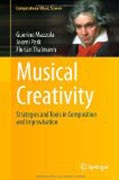
Musical creativity: strategies and tools in composition and improvisation
Mazzola, Guerino
Park, Joomi
Thalmann, Florian
This book represents a new approach to musical creativity, dealing with the semiotics, mathematical principles, and software for creativity processes.. After a thorough introduction, the book offers a first practical part with a detailed tutorial for students in composition and improvisation, using musical instruments and music software. The second, theoretical part deals with historical, actual, and new principles of creative processes in music, based on the results and methods developed in the first author’s book Topos of Music and referring to semiotics, predicative objects, topos theory, and object-oriented concept architectures. The third part of the book details four case studies in musical creativity, including an analysis of the six variations of Beethoven's sonata op. 109, a discussion of the creative process in a CD coproduced in 2011 by the first and second authors, a recomposition of Boulez’s 'Structures pour deux pianos' using the Rubato software module BigBang developed by the third author, and the Escher theorem from mathematical gesture theory in music.. Thisis both a textbook addressed to undergraduate and graduate students of music composition and improvisation, and also a state-of-the-art survey addressed toresearchers in creativity studies and music technology. The book contains summaries and end-of-chapter questions, and the authors have used the book as themain reference to teach an undergraduate creativity studies program and also to teach composition. The text is supported throughout with musical score examples. Represents a new approach to musical creativity, dealing with software andthe semiotics and mathematical principles of creativity processes. Supported throughout with musical score examples, and the authors' related music and video examples are freely available online. Authors have used the book as the main reference for an undergraduate creativity studies program. INDICE: Part I Introduction. Chap. 1 What the Book Is About. Chap. 2 Oniontology. Part II Practice. Chap. 3 The Tutorial. Chap. 4 Leitfaden. Chap. 5 TheGeneral Method of Creativity. Chap. 6 Getting off the Ground. Chap. 7 Motivational Aspects. Chap. 8 Rhythmical Aspects. Chap. 9 The Pitch Aspect. Chap. 10 The Harmonic Aspect. Chap. 11 Melodic Aspects. Chap. 12 The Contrapuntal Aspect. Chap. 13 Instrumental Aspects. Chap. 14 Large Form Aspects. Chap. 15 Community Aspects. Chap. 16 Commercial Aspects. Chap. 17 Dodecaphonic Aspects. Part III Theory. Chap. 18 Principles of Creative Pedagogy. Chap. 19 Material. Chap.20 Historical Principles. Chap. 21 Present Principles. Chap. 22 Our Principles. Chap. 23 First Examples. Chap. 24 Psychological Perspectives. Chap. 25 Software. Chap. 26 Composition and Improvisation. Part IV Case Studies. Chap. 27 Ludwig van Beethoven’s Op109: Six Variations. Chap. 28 Beethoven’s Op109: Improvisational Aspects. Chap. 29 Our CD. Chap. 30 Boulez: Structures Recomposed. Chap. 31 The Escher Theorem. Part V Future Perspectives. Chap. 32 Is There a General Scheme for Creativity?. Chap. 33 The Balanced Dancing Performer. References. Bibliography.
- ISBN: 978-3-642-24516-9
- Editorial: Springer Berlin Heidelberg
- Encuadernacion: Cartoné
- Páginas: 338
- Fecha Publicación: 30/11/2011
- Nº Volúmenes: 1
- Idioma: Inglés
